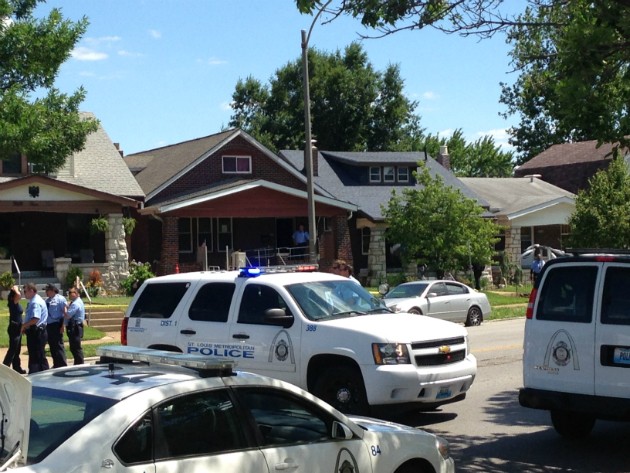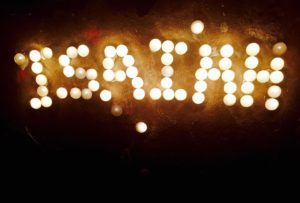Filed under: Action, Analysis, Community Organizing, Police, Southeast

To donate to Isaiah’s funeral fund, please go here!
Isaiah Hammett was murdered by St Louis City police officers on June 7th during a SWAT raid. Missouri is a state that paradoxically has both a castle doctrine (you have the right to defend your home from known and unknown intruders) and also allows for no-knock police raids. For those of you who are unfamiliar, no knock raids typically occur in the following manner: STLMPD SWAT arrives at the house, “announces” their presence, busts through the front door, and throws flash bang grenades inside to “cause a diversion.” Not surprisingly, this is often followed by some amount of gunfire.
All and all, over a 100 rounds were fired by police in and outside of the house, including numerous buckshot through the floor where Isaiah’s body came to rest—presumably the police continued to shoot at him even after he was on the ground. Isaiah’s Grandpa, Daniel Torres, a disabled Vietnam War vet, was home with Isaiah when the raid occurred. He was saved death when Isaiah came into his room as the shooting started and threw him off his bed. Walking around the house, you see the aftermath of a war zone. Bullet holes everywhere, through drywall, plaster walls, brick, a window frame, the floor.
It is a requirement of STLMPD that they must live inside the city limits for 7 years. When the city first sought to establish this residential rule, many police threatened to quit. Naturally, cops live in their own ghettos. Isaiah lived in one such neighborhood, Bevo, in South St Louis. Bevo has some of the highest proportions of residents who are either police or police sympathizers. Walking around, you’re bound to see someone wearing a Blue Lives Matter bracelet or see a blue light shining on a porch. Ultimately, this is to illuminate that Isaiah and his family stuck it out as outliers in the neighborhood. Being a very racially mixed family lends no benefit. They have continually been a target— police perceived them as breeding crime and disorder. In fact, adding to the police’s disdain, Isaiah dated the niece of former STL police chief, Sam Dotson. Dotson was none too happy about this.
So what did occur on the day Isaiah was murdered?
There is a quite a bit of confusion about what happened that day. Did Isaiah shoot back? Did the police come in to execute him? We don’t know exactly and we could theorize all we want. What we do know is that the police lie all the time. We also know that people in STL—for good reason—often defend themselves from police aggression. We are not part of his family, but rather supporters, and we do not wish to overspeculate. We just know that the police lie. And that in addition to lying, their mere existence is problematic. We are all too aware of the ways the police are intertwined with the poverty and power structures that dictate our lives.
If Isaiah shot back, we can poke holes in the story on either side. Didn’t he have the right, according to Missouri’s Castle doctrine, to defend his house from an intruder? Especially because the police DIDN’T KNOCK. This very type of law was used to acquit George Zimmerman when he murdered Trayvon Martin. This just goes to show that laws have little sway when you are on the wrong side of the class and race divide.
The gun laws in Missouri are some of the most relaxed in the nation. License of ownership and firearm registration are not mandatory in this state. However, all of Isaiah’s and his grandfather’s guns were registered. Friends and family say that the AK he allegedly used against the police was broken and didn’t actually work. And some claim that the bullet holes don’t look like AK holes. Isaiah had an appointment to get his AK fixed the day he was gunned down.
We can never know if the police executed him in cold blood. This seems entirely possible considering the years of intense police harassment his family has withstood. The police always have the benefit of being louder than those of us who have no power. Subsequently, it wouldn’t be hard to cover up an execution. The police can and do make up stories to justify their brutality and their mistakes. Some of these stories are incredibly elaborate. Anyone who has ever read their own police arrest report knows this. They’re not necessarily very good at it, but because they have the full power of the state and capital behind them it doesn’t matter if they fabricate stories or not.
In the end, we don’t think these are the questions to ask. We’ll likely never get conclusive answers and besides, in moments like these quick and unpredictable things happen. Those in power are more effective when we let them operate from behind a mysterious shroud as opposed to naming the fundamental reasons the police exist—to enforce class and racial supremacy. The day to day experiences that many of us have add up to this truth. People react to this mission in various ways, some are combative, some evasive, some passive. Most of the time just merely existing is enough to be a problem.
The last days some of us have been connecting with his friends and family, offering as much support as we can. They want action and they don’t want his name to be lost. It has been difficult, but this family is fierce and courageous. A street smarts exists amongst folks when it comes to the police; many know the police are a gang that doesn’t settle disputes but seeks to inflame and keep you in your place as a POC/broke person. Stopping you on the street, throwing your family members in and out of prison; getting you to snitch on one another. The end result is generations of folks who have no love or faith in the police.
Additionally, in St Louis there are police officers assigned to the building division to work on “problem properties,” often houses where drugs or guns are allegedly run out of. The city immediately inspected the Hammett’s house and will condemn the property in 10 days if they don’t fix the laundry list code violations-this includes PATCHING UP ALL THE BULLET HOLES. They are doing this family dirty.
We’ll spare you the details of the interactions we’ve had throughout all this— we’re not sociologists or voyeurs looking to reveal or personally benefit from these meaningful subterranean conversations. Much of what is discussed does not conform to the usual academic or facebook activist narratives. One thing that markedly stands out is that this whole situation firmly challenges much of what passes for liberal and ally-based anti-racist discourses. We direly need to break from these discourses—they are based on homogenous State-like understandings of people and not the day-to-day reality of the confusing and complicated ways that race and class intersect. If we don’t, we’ll continue to reinforce the State’s logic of identity, a logic that either imposes victimhood or criminality upon us—depending on if it’s a liberal or conservative bent. We must see the multiplicity of identity and ability, intelligence and creativity of others to name and attack their conditions, often in ways that do not conform to an organizer meeting, a civil disobedience action, or spectacular armed struggle. We must embrace the strength that we are ALL agents, resistant and self-organized in ways that are not legible to those who seek to control or speak for our lives.
POSTSCRIPT
There’s seems to be some steam building. Making connections with folks, using our tired old printing scams to make fliers, bringing food and talking for hours has started the beginnings of friendships. More friends and family are getting fired up and ready to be in the streets. Last night a roving march went through the neighborhood with the purpose of garnering support, making noise, passing out fliers. We eventually found ourselves at a bar and we were welcomed with open arms by all the patrons. Shots were taken for Isaiah. The camaraderie of the scene was powerful.
Sadly, the police killed another man last night. The 5th this year. This sent the police on edge. People wanted to react but before we could, the police eventually surrounded the march, calling it an unlawful assembly and threatened chemical munitions. As the 20 or so folks march came back to Isaiah’s house, a cop told everyone to leave because the house is condemned—this is not entirely true yet because the legal process is still in motion. Down the street, 20-30 police cruisers waited. It was hard to tell if this was a bluff or real. In the end, it seemed like a bluff, but it still caused some panic. People stood their ground and the police eventually left. These intimidation tactics are an escalation and it’s very likely that they will continue.







